Gigabyte GA-H61M-D2-B3 (rev. 1.0) User Manual [ru]

GA-H61M-D2-B3
LGA1155 socket motherboard for Intel® Core™ i7 processors/ Intel® Core™ i5 processors/Intel® Core™ i3 processors/
Intel® Pentium® processors/Intel® Celeron® processors
User's Manual
Rev. 1001
12ME-H61MD2B-1001R
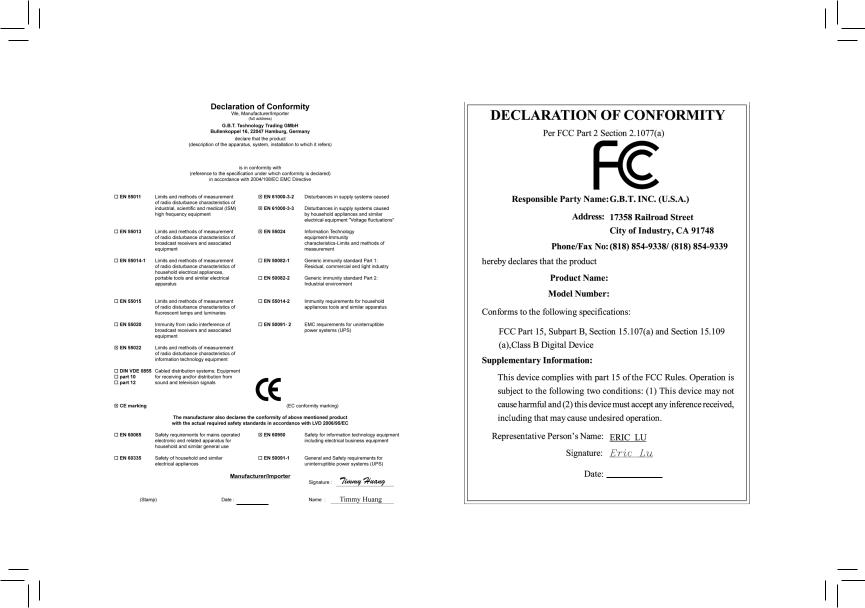
dr aobr eht o M
GA-H61M-D2-B3
Motherboard
GA-H61M-D2-B3
Jan. 18, 2011
Jan. 18, 2011

Copyright
© 2011 GIGA-BYTE TECHNOLOGY CO., LTD. All rights reserved.
The trademarks mentioned in this manual are legally registered to their respective owners.
Disclaimer
Information in this manual is protected by copyright laws and is the property of GIGABYTE.
Changes to the specifications and features in this manual may be made by GIGABYTE without prior notice. No part of this manual may be reproduced, copied, translated, transmitted, or published in any form or by any means without GIGABYTE's prior written permission.
In order to assist in the use of this product, carefully read the User's Manual.
For product-related information, check on our website at: http://www.gigabyte.com
Identifying Your Motherboard Revision
The revision number on your motherboard looks like this: "REV: X.X." For example, "REV: 1.0" means the revision of the motherboard is 1.0. Check your motherboard revision before updating motherboard BIOS, drivers, or when looking for technical information.
Example:

Table of Contents
GA-H61M-D2-B3 Motherboard Layout............................................................................ |
5 |
|
Chapter 1 Hardware Installation...................................................................................... |
6 |
|
1-1 |
Installation Precautions.................................................................................... |
6 |
1-2 |
Product Specifications...................................................................................... |
7 |
1-3 |
Installing the CPU and CPU Cooler................................................................. |
9 |
1-4 |
Installing the Memory..................................................................................... |
10 |
1-5 |
Installing an Expansion Card......................................................................... |
10 |
1-6 |
Back Panel Connectors................................................................................... |
11 |
1-7 |
Internal Connectors........................................................................................ |
12 |
Chapter 2 BIOS Setup................................................................................................... |
20 |
|
2-1 |
Startup Screen............................................................................................... |
20 |
2-2 |
The Main Menu............................................................................................... |
20 |
2-3 |
MB Intelligent Tweaker(M.I.T.)........................................................................ |
21 |
2-4 |
Standard CMOS Features.............................................................................. |
28 |
2-5 |
Advanced BIOS Features............................................................................... |
29 |
2-6 |
Integrated Peripherals.................................................................................... |
31 |
2-7 |
Power Management Setup............................................................................. |
32 |
2-8 |
PC Health Status............................................................................................ |
34 |
2-9 |
Load Fail-Safe Defaults.................................................................................. |
35 |
2-10 |
Load Optimized Defaults................................................................................ |
35 |
2-11 |
Set Supervisor/User Password...................................................................... |
36 |
2-12 |
Save & Exit Setup........................................................................................... |
36 |
2-13 |
Exit Without Saving........................................................................................ |
37 |
Chapter 3 Drivers Installation........................................................................................ |
37 |
|
- 4 -

GA-H61M-D2-B3 Motherboard Layout
KB_MS |
|
|
DVI |
ATX_12V |
|
LGA1155 |
||
VGA |
||
|
R_USB2
R_USB1
USB_LAN |
CPU_FAN |
|
|
|
|
AUDIO |
Realtek |
|
|
|
|
|
RTL8111E |
|
M_BIOS |
B_BIOS |
BAT |
|
PCIEX16
CODEC |
PCIEX1_1 |
GA-H61M-D2-B3 |
|
|
ATX
DDR3 1 |
DDR3 2 |
PCIEX1_2
SYS_FAN
PCIEX1_3
F_AUDIO COMA
iTE IT8728
LPT
Intel® H61 |
CLR_CMOS |
|
|
|
|
||
CI |
1 |
0 |
|
3 SATA2 |
2 SATA2 |
||
PWR_LED |
|||
SATA2 |
SATA2 |
||
F_USB2 F_USB1 |
|||
|
|
||
F_PANEL |
|
|
Box Contents
GA-H61M-D2-B3 motherboard |
|
Motherboard driver disk |
Two SATA cables |
User's Manual |
I/O Shield |
*The box contents above are for reference only and the actual items shall depend on the product package you obtain.
-5 -

Chapter 1 Hardware Installation
1-1 Installation Precautions
The motherboard contains numerous delicate electronic circuits and components which can become damaged as a result of electrostatic discharge (ESD). Prior to installation, carefully read the user's manual and follow these procedures:
•• Prior to installation, do not remove or break motherboard S/N (Serial Number) sticker or warranty sticker provided by your dealer. These stickers are required for warranty validation.
•• Always remove the AC power by unplugging the power cord from the power outlet before installing or removing the motherboard or other hardware components.
•• When connecting hardware components to the internal connectors on the motherboard, make sure they are connected tightly and securely.
•• When handling the motherboard, avoid touching any metal leads or connectors.
•• It is best to wear an electrostatic discharge (ESD) wrist strap when handling electronic components such as a motherboard, CPU or memory. If you do not have an ESD wrist strap, keep your hands dry and first touch a metal object to eliminate static electricity.
•• Prior to installing the motherboard, please have it on top of an antistatic pad or within an electrostatic shielding container.
•• Before unplugging the power supply cable from the motherboard, make sure the power supply has been turned off.
•• Before turning on the power, make sure the power supply voltage has been set according to the local voltage standard.
•• Before using the product, please verify that all cables and power connectors of your hardware components are connected.
•• To prevent damage to the motherboard, do not allow screws to come in contact with the motherboard circuit or its components.
•• Make sure there are no leftover screws or metal components placed on the motherboard or within the computer casing.
•• Do not place the computer system on an uneven surface.
•• Do not place the computer system in a high-temperature environment.
•• Turning on the computer power during the installation process can lead to damage to system components as well as physical harm to the user.
•• If you are uncertain about any installation steps or have a problem related to the use of the product, please consult a certified computer technician.
Hardware Installation |
- 6 - |
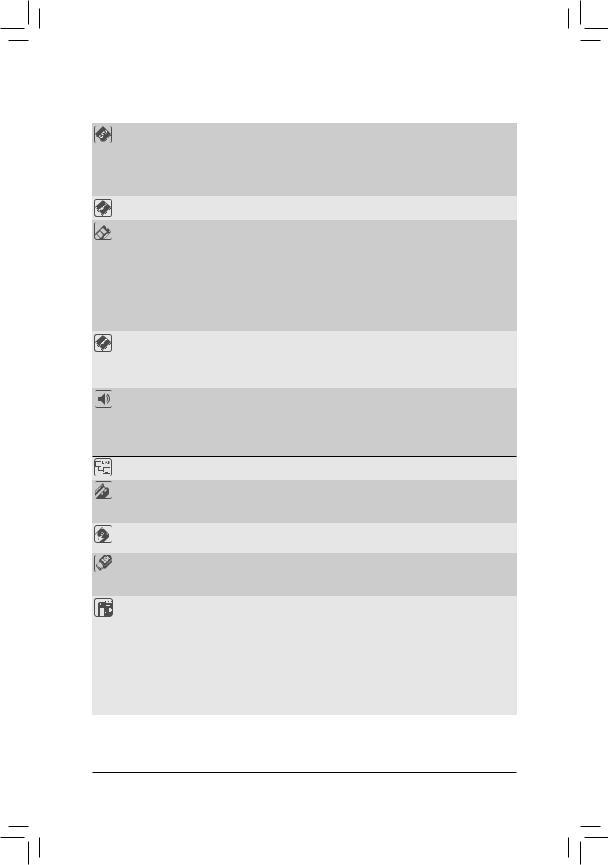
1-2 |
Product Specifications |
||
|
|
|
|
|
CPU |
Support for Intel® Core™ i7 processors/Intel® Core™ i5 processors/ |
|
|
|
Intel® Core™ i3 processors/Intel® Pentium® processors/Intel® Celeron® processors |
|
|
|
in the LGA1155 package |
|
|
|
(Go to GIGABYTE's website for the latest CPU support list.) |
|
|
|
L3 cache varies with CPU |
|
|
Chipset |
Intel® H61 Express Chipset |
|
|
Memory |
2 x 1.5V DDR3 DIMM sockets supporting up to 16 GB of system memory |
|
|
|
|
* Due to Windows 32-bit operating system limitation, when more than 4 GB of physical |
|
|
|
memory is installed, the actual memory size displayed will be less than 4 GB. |
|
|
Dual channel memory architecture |
|
|
|
Support for DDR3 1333/1066/800 MHz memory modules |
|
|
|
Support for non-ECC memory modules |
|
|
|
(Go to GIGABYTE's website for the latest supported memory speeds and memory |
|
|
|
modules.) |
|
|
Onboard |
Integrated in the Chipset: |
|
|
Graphics |
- |
1 x D-Sub port |
-1 x DVI-D port, supporting a maximum resolution of 1920x1200
*The DVI-D port does not support D-Sub connection by adapter.
Audio |
|
Realtek ALC889 codec |
|
High Definition Audio |
|
|
|
2/4/5.1/7.1-channel |
*Toconfigure 7.1-channel audio, you need connect withtheport ofHDAudiostandard via front panel and enable the multi-channel audio feature through the audio driver.
LAN |
|
1 x Realtek RTL8111E chip (10/100/1000 Mbit) |
|
|
|
|
|
Expansion Slots |
|
1 x PCI Express x16 slot, running at x16 |
|
|
|
3 x PCI Express x1 slots |
|
|
|
(All PCI Express slots conform to PCI Express 2.0 standard.) |
|
Storage Interface |
|
Chipset: |
|
|
|
- |
4 x SATA 3Gb/s connectors supporting up to 4 SATA 3Gb/s devices |
USB |
|
Chipset: |
|
|
|
- |
Up to 10 USB 2.0/1.1 ports (6 on the back panel, 4 via the USB brackets |
|
|
|
connected to the internal USB headers) |
Internal |
|
1 x 24-pin ATX main power connector |
|
Connectors |
|
1 x 4-pin ATX 12V power connector |
|
|
|
4 x SATA 3Gb/s connectors |
|
|
|
1 x CPU fan header |
|
|
|
1 x system fan header |
|
|
|
1 x front panel header |
|
|
|
1 x front panel audio header |
|
|
|
2 x USB 2.0/1.1 headers |
|
- 7 - |
Hardware Installation |

Internal |
|
1 x parallel port header |
|
Connectors |
|
1 x serial port header |
|
|
1 x power LED header |
||
|
1 x chassis intrusion header |
||
|
1 x clearing CMOS jumper |
||
Back Panel |
|
1 x PS/2 keyboard port |
|
Connectors |
|
1 x PS/2 mouse port |
|
|
1 x D-Sub port |
||
|
1 x DVI-D port |
||
|
6 x USB 2.0/1.1 ports |
||
|
1 x RJ-45 port |
||
|
3 x audio jacks (Line In/Line Out/Microphone) |
||
I/O Controller |
|
iTE IT8728 chip |
|
|
|
|
|
Hardware |
|
System voltage detection |
|
Monitor |
|
CPU/System temperature detection |
|
|
CPU/System fan speed detection |
||
|
CPU/System fan speed control |
||
|
|
* Whether the CPU/system fan speed control function is supported will depend on |
|
|
|
the CPU/system cooler you install. |
|
BIOS |
|
2 x 32 Mbit flash |
|
|
Use of licensed AWARD BIOS |
||
|
Support for DualBIOS™ |
||
|
PnP 1.0a, DMI 2.0, SM BIOS 2.4, ACPI 1.0b |
||
Unique Features |
|
Support for @BIOS |
|
|
|
Support for Q-Flash |
|
|
Support for Xpress BIOS Rescue |
||
|
Support for Download Center |
||
|
Support for Xpress Install |
||
|
Support for Xpress Recovery2 |
||
|
Support for EasyTune |
||
|
|
* Available functions in EasyTune may differ by motherboard model. |
|
|
Support for Smart 6™ |
||
|
Support for Auto Green |
||
|
Support for ON/OFF Charge |
||
|
Support for Cloud OC |
||
|
|
Support for Q-Share |
|
Bundled |
Norton Internet Security (OEM version) |
||
Software |
|||
|
|
||
Operating |
Support for Microsoft® Windows 7/Vista/XP |
||
System |
|||
|
|
||
Form Factor |
|
Micro ATX Form Factor; 24.4cm x 19.5cm |
|
* GIGABYTE reserves the right to make any changes to the product specifications and product-related information without prior notice.
Hardware Installation |
- 8 - |
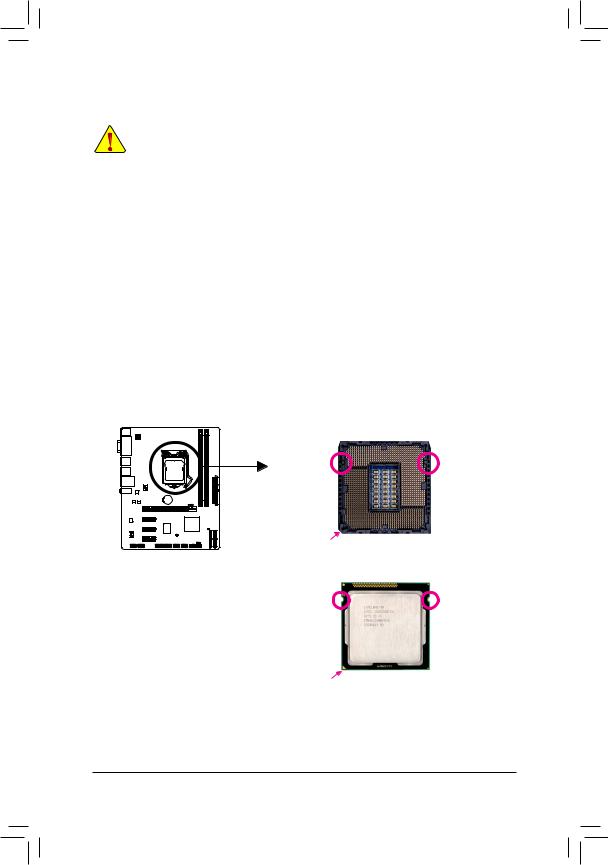
1-3 |
Installing the CPU and CPU Cooler |
|
|
Read the following guidelines before you begin to install the CPU: |
|
|
•• |
Make sure that the motherboard supports the CPU. |
|
|
(Go to GIGABYTE's website for the latest CPU support list.) |
|
•• |
Always turn off the computer and unplug the power cord from the power outlet before installing |
|
|
the CPU to prevent hardware damage. |
|
•• |
Locate the pin one of the CPU. The CPU cannot be inserted if oriented incorrectly. (Or you may |
|
|
locate the notches on both sides of the CPU and alignment keys on the CPU socket.) |
|
•• |
Apply an even and thin layer of thermal grease on the surface of the CPU. |
|
•• |
Do not turn on the computer if the CPU cooler is not installed, otherwise overheating and dam- |
|
|
age of the CPU may occur. |
|
•• |
Set the CPU host frequency in accordance with the CPU specifications. It is not recommended |
|
|
that the system bus frequency be set beyond hardware specifications since it does not meet the |
|
|
standard requirements for the peripherals. If you wish to set the frequency beyond the standard |
|
|
specifications, please do so according to your hardware specifications including the CPU, graph- |
|
|
ics card, memory, hard drive, etc. |
Installing the CPU
A. Locate the alignment keys on the motherboard CPU socket and the notches on the CPU.
LGA1155 CPU Socket
Alignment Key |
Alignment Key |
Pin One Corner of the CPU Socket
LGA1155 CPU
Notch |
Notch |
Triangle Pin One Marking on the CPU
- 9 - |
Hardware Installation |
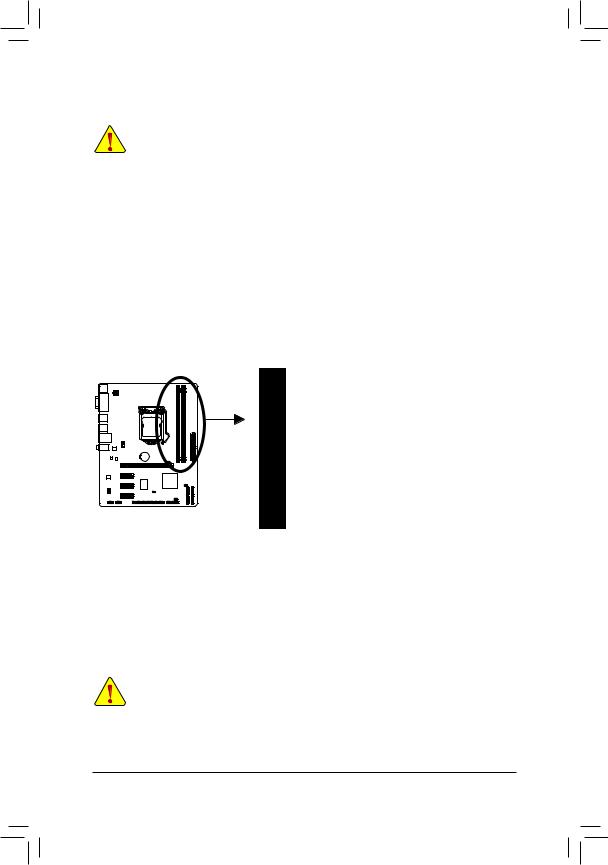
1-4 Installing the Memory
Read the following guidelines before you begin to install the memory:
•• Make sure that the motherboard supports the memory. It is recommended that memory of the same capacity, brand, speed, and chips be used.
(Go to GIGABYTE's website for the latest supported memory speeds and memory modules.)
•• Always turn off the computer and unplug the power cord from the power outlet before installing the memory to prevent hardware damage.
•• Memory modules have a foolproof design. A memory module can be installed in only one direction. If you are unable to insert the memory, switch the direction.
Dual Channel Memory Configuration
This motherboard provides two DDR3 memory sockets and supports Dual Channel Technology. After the memory is installed, the BIOS will automatically detect the specifications and capacity of the memory. Enabling Dual Channel memory mode will double the original memory bandwidth.
The two DDR3 memory sockets are divided into two channels and each channel has one memory socket as following:
 Channel 0: DDR3_1
Channel 0: DDR3_1  Channel 1: DDR3_2
Channel 1: DDR3_2
DDR3_2
DDR3_1
Due to CPU limitations, read the following guidelines before installing the memory in Dual Channel mode. 111 Dual Channel mode cannot be enabled if only one DDR3 memory module is installed.
222When enabling Dual Channel mode with two memory modules, it is recommended that memory of the same capacity, brand, speed, and chips be used for optimum performance.
1-5 Installing an Expansion Card
Read the following guidelines before you begin to install an expansion card:
•Make sure the motherboard supports the expansion card. Carefully read the manual that came with your expansion card.
•Always turn off the computer and unplug the power cord from the power outlet before installing an expansion card to prevent hardware damage.
Hardware Installation |
- 10 - |
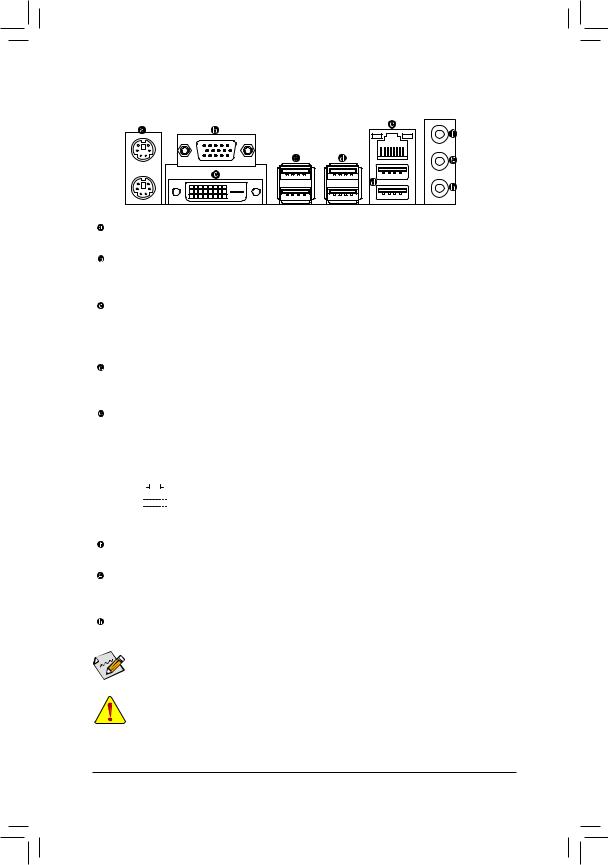
1-6 Back Panel Connectors
PS/2 Keyboard and PS/2 Mouse Port
Use the upper port (green) to connect a PS/2 mouse and the lower port (purple) to connect a PS/2 keyboard.
D-Sub Port
The D-Sub port supports a 15-pin D-Sub connector. Connect a monitor that supports D-Sub connection to this port.
DVI-D Port (Note)
The DVI-D port conforms to the DVI-D specification and supports a maximum resolution of 1920x1200
(the actual resolutions supported depend on the monitor being used). Connect a monitor that supports DVI-D connection to this port.
USB 2.0/1.1 Port
The USB port supports the USB 2.0/1.1 specification. Use this port for USB devices such as a USB keyboard/mouse, USB printer, USB flash drive and etc.
RJ-45 LAN Port
The Gigabit Ethernet LAN port provides Internet connection at up to 1 Gbps data rate. The following describes the states of the LAN port LEDs.
Connection/ |
|
|
|
|
Activity LED |
Connection/Speed LED: |
|
Activity LED: |
|||||||||||
Speed LED |
|
|
|
|
|
||||||||||||||
|
|
|
|
|
|
|
|
|
|
|
|
|
|
|
State |
Description |
|
State |
Description |
|
|
|
|
|
|
|
|
|
|
|
|
|
|
|
Orange |
1 Gbps data rate |
|
Blinking |
Data transmission or receiving is occurring |
|
|
|
|
|
|
|
|
|
|
|
|
|
|
|
Green |
100 Mbps data rate |
|
Off |
No data transmission or receiving is occurring |
|
|
|
|
LAN Port |
Off |
10 Mbps data rate |
|
|
|
||||||||||
|
|
|
|
|
|
|
|
|
|||||||||||
Line In Jack (Blue)
The default line in jack. Use this audio jack for line in devices such as an optical drive, walkman, etc.
Line Out Jack (Green)
The default line out jack. Use this audio jack for a headphone or 2-channel speaker. This jack can be used to connect front speakers in a 4/5.1/7.1-channel audio configuration.
Mic In Jack (Pink)
The default Mic in jack. Microphones must be connected to this jack.

 To configure 7.1-channel audio, you need connect with the port of HD Audio standard via front panel and enable the multi-channel audio feature through the audio driver.
To configure 7.1-channel audio, you need connect with the port of HD Audio standard via front panel and enable the multi-channel audio feature through the audio driver.
•• When removing the cable connected to a back panel connector, first remove the cable from your device and then remove it from the motherboard.
•• When removing the cable, pull it straight out from the connector. Do not rock it side to side to prevent an electrical short inside the cable connector.
(Note) The DVI-D port does not support D-Sub connection by adapter. |
|
- 11 - |
Hardware Installation |
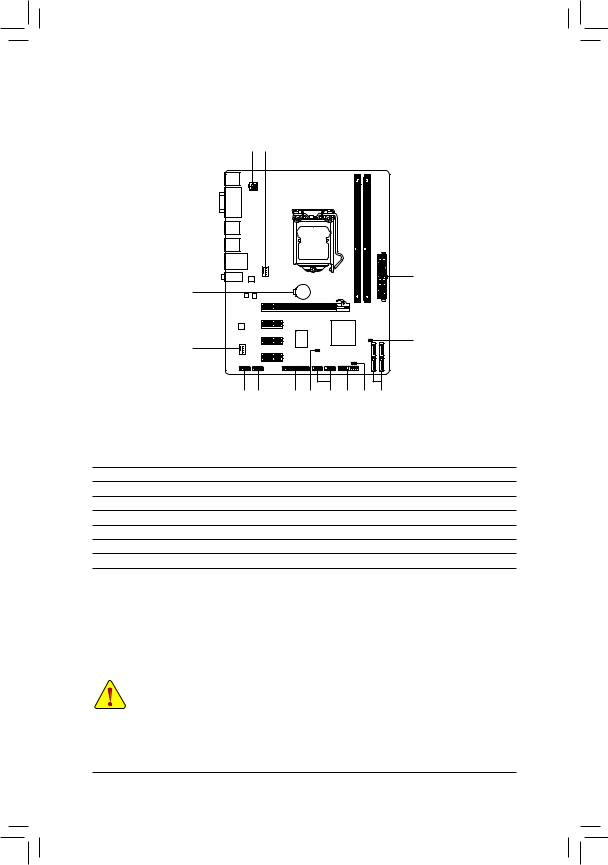
1-7 Internal Connectors
1 3
2
14
13
4
7 9 10 11 8 6 12 5
1) |
ATX_12V |
8) |
F_USB1/2 |
2) |
ATX |
9) |
COMA |
3) |
CPU_FAN |
10) |
LPT |
4) |
SYS_FAN |
11) |
CI |
5) |
SATA2_0/1/2/3 |
12) |
PWR_LED |
6) |
F_PANEL |
13) |
CLR_CMOS |
7) |
F_AUDIO |
14) |
BAT |
Read the following guidelines before connecting external devices:
•• First make sure your devices are compliant with the connectors you wish to connect.
•• Before installing the devices, be sure to turn off the devices and your computer. Unplug the power cord from the power outlet to prevent damage to the devices.
•• After installing the device and before turning on the computer, make sure the device cable has been securely attached to the connector on the motherboard.
Hardware Installation |
- 12 - |
